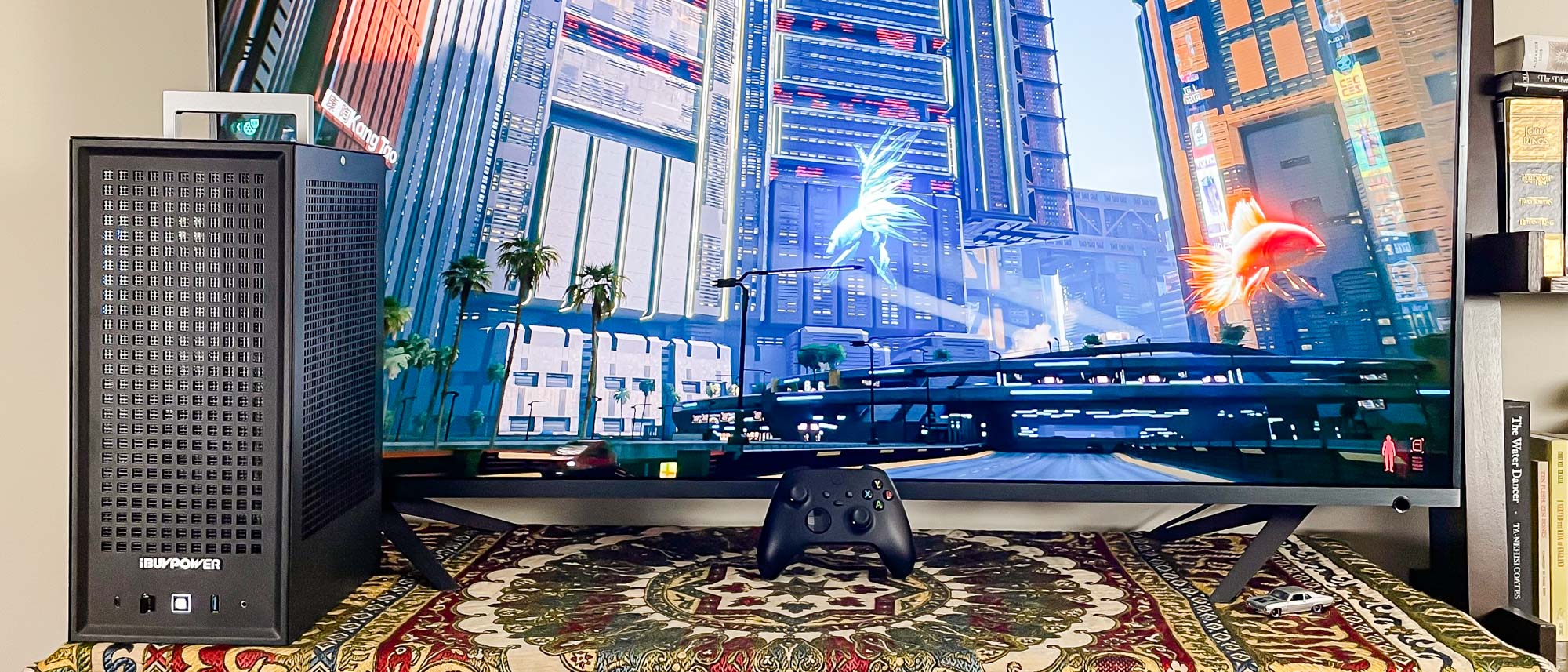Tom's Guide Verdict
The iBuypower Revolt 3 seems tailor-made for LAN parties and college dorm rooms, but anyone looking for a compact, understated gaming PC with plenty of power will be well-served.
Pros
- +
Compact case is easy to move around
- +
Great performance for the price
- +
Easy-open case design works well
- +
Unique port locations create streamlined look
Cons
- -
Unique port locations limit placement options
- -
Cramped interior makes upgrades and modifications tricky
Why you can trust Tom's Guide
Price: $3,199 (as configured)
Processor: AMD Ryzen 9 5900X
RAM: 16GB DDR4
Graphics card: Nvidia GeForce RTX 3080 Ti
Storage: 1TB WD Blue SN570 M.2 PCIe NVMe SSD
Accessories: n/a
Ports: 4x USB 3.2 Gen 1, 1x USB 3.2 Gen 2 Type-A, RJ-45 Ethernet, 2x HDMI, 2x DisplayPort, audio/antenna port arrays on bottom; 2x USB-A, 1x USB-A, headphone jack on front
Size: 16.1 x 9.9 x 7 inches
The iBuypower Revolt 3 ($3,199 as reviewed) seems tailor-made for LAN parties and college dorms. The eye-catching Revolt 3 case from iBuypower sister company Hyte is a tall, trim tower with a built-in handle, and now the company is offering prebuilt gaming PCs which pack it with plenty of gaming muscle.
Our iBuypower Revolt 3 review unit shows off what this trashcan-sized gaming PC can do with top-tier components from AMD and Nvidia, as it competed favorably in our gaming tests with a compact gaming rig that costs twice as much.
The unique case design brings with it some unique issues that you should know before buying, but if you like the look of it the iBuypower Revolt 3 is one of the best gaming PCs you can buy — especially if you plan to be lugging it back and forth between home, school, the office, and wherever else you need the power of an Nvidia GeForce RTX 3080 Ti.
iBuyPower Revolt 3 review: Price and availability
- Custom iBuypower PC in Revolt 3 ITX case (also sold separately)
- Expect to pay between $2-$5k for prebuilt ($3,199 as reviewed)
You can buy a variety of prebuilt gaming PCs from iBuypower and third-party retailers like Newegg, or customize your own via the company’s website. Your options for configuring a prebuilt PC will vary depending on when you order and what components the company has in stock.

Our review unit retails for $3,199, and packs an AMD Ryzen 9 5900X CPU, an Nvidia GeForce RTX 3080 Ti graphics card, 16GB of DDR-3200 RAM and a 1TB M.2 PCIe NVMe Western Digital SSD inside a tall, trim Revolt 3 mini-ITX case with a 240mm liquid cooler.
iBuyPower Revolt 3 review: Design
- Revolt 3 case is compact, understated and easy to carry
- Built-in handle and headphone rests are a nice touch
The Revolt 3 case our review unit showed up in is a mini-ITX case from iBuypower sister brand Hyte that you can buy separately for $129 (via Hyte's website), and it has a real love-it-or-hate-it design. Personally I think I love it, but you should get a sense of how you'll feel about its compact design before you buy.
The Revolt 3 measures roughly 16.1 x 9.9 x 7 inches and looks a bit like a bigger Xbox Series X (11.8 x 5.9 x 5.9 inches) with glowing innards. However, unlike the Series X the Revolt 3 is available in either black or white, and it's pretty easy to move around thanks to the pop-out aluminum handle built into the top of the case. A pair of aluminum pegs embedded on the top edge of either side can also be popped out to hold headphones, or whatever else you care to hang off them.
Get instant access to breaking news, the hottest reviews, great deals and helpful tips.
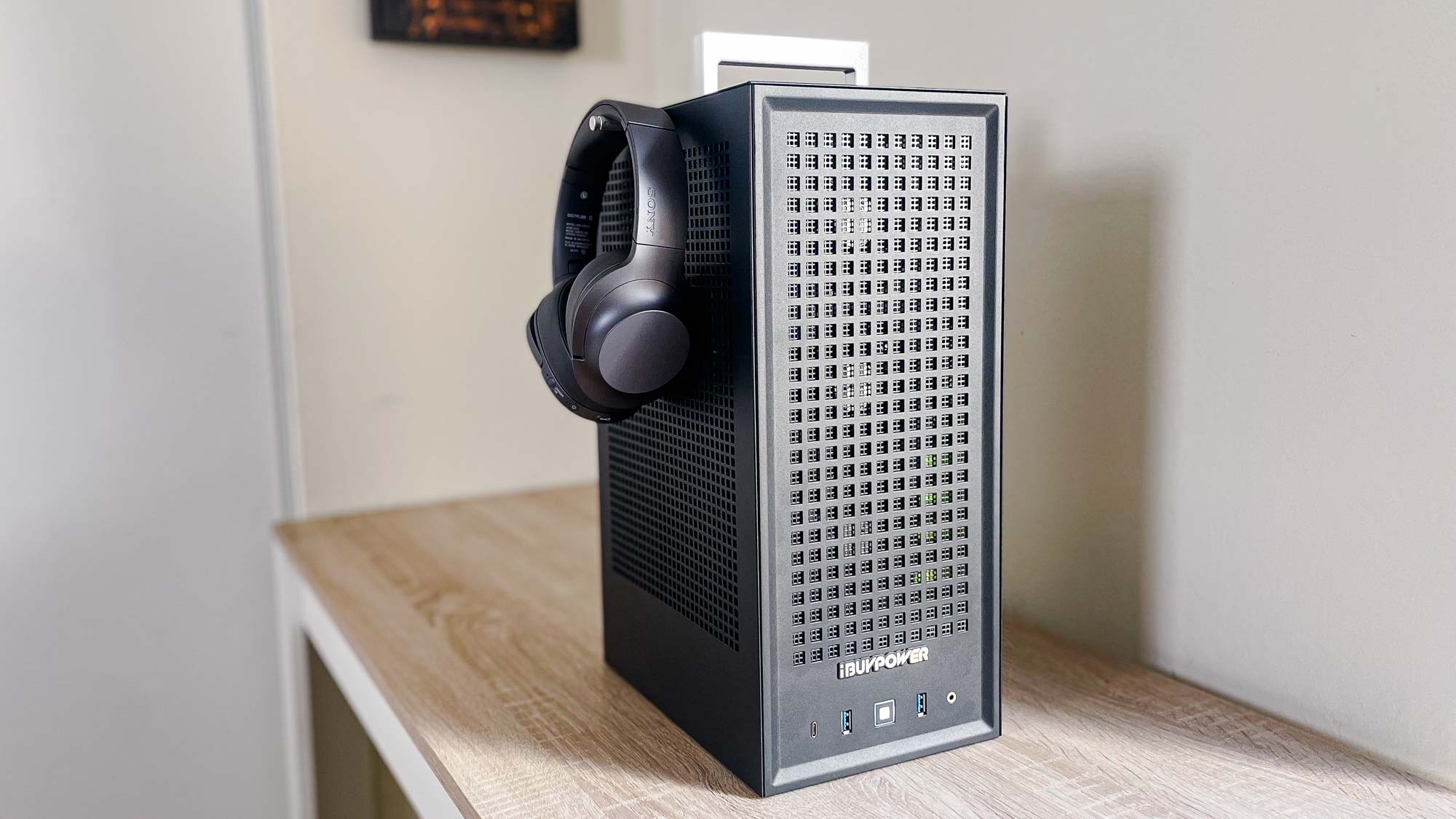
The Revolt 3’s rectangular steel sides sport a pattern of square cutouts overlaid with mesh, enhancing airflow and allowing the RGB LEDs inside the case to shine out from behind a cage of metal. Each side of the case can be popped on or off without tools once you get the hang of the mechanism, making it pretty easy to get inside the case when necessary. It’s tight in there, however, so don’t expect to have an easy time upgrading or swapping out components.
Along the bottom front lip of the case you’ll find the power button flanked by a port array that includes both USB-A and USB-C ports as well as a headphone jack. You’ll find the rest of the ports on the bottom of the Revolt 3, which is elevated off the floor by its four sides. This creates a little cavern underneath the PC accessed by a cutout at the bottom of the rear panel, with the idea being that you run your cables in through this hole in the back and plug them into the bottom of the PC.
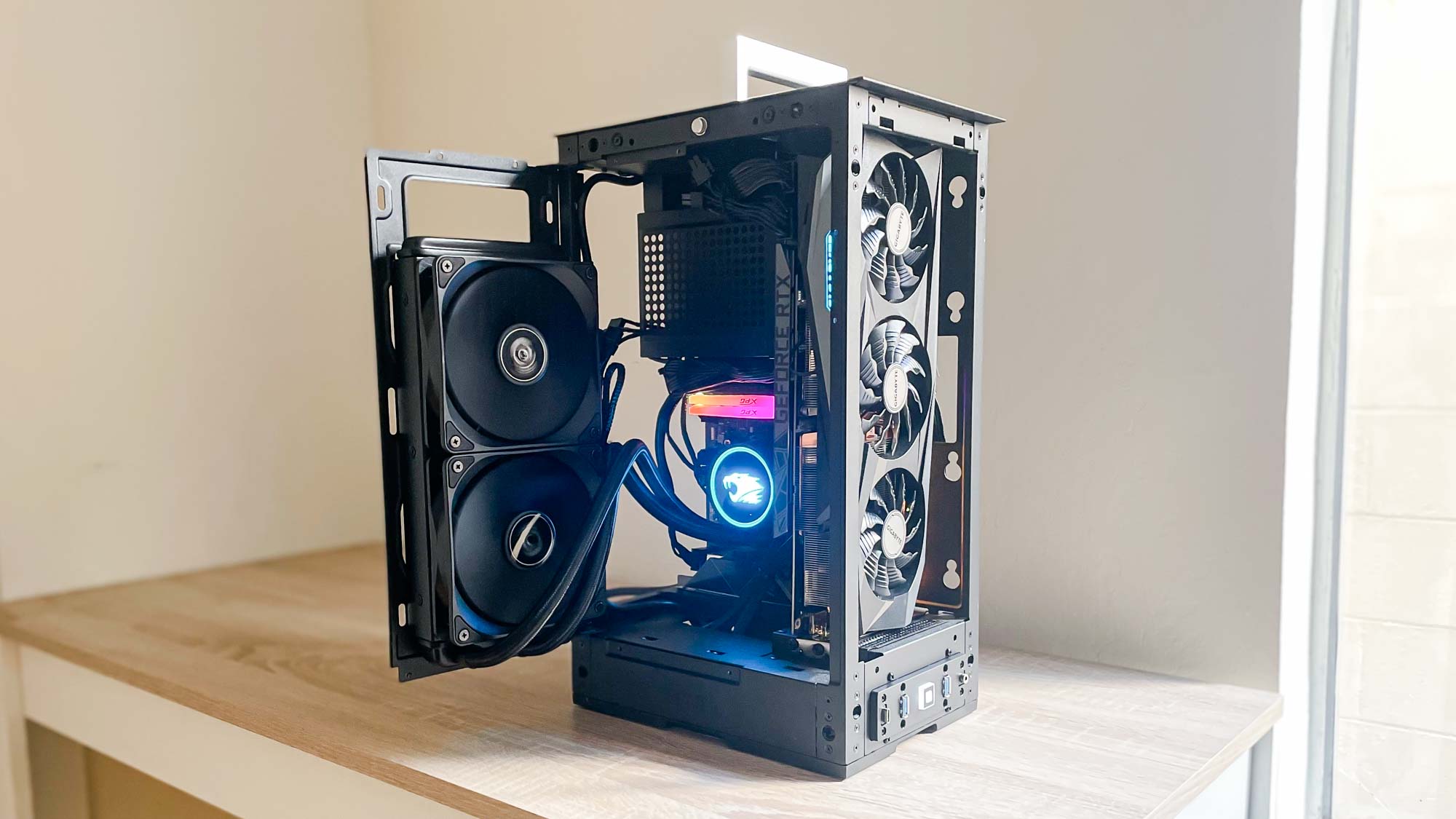
It’s an interesting design choice that gives the Revolt 3 a striking, nearly cable-free look. However, this also means you’ll have to pick the PC up or tip it over every time you want to get at those ports, which can be a hassle. It also means that this case isn’t well-suited to sitting on the floor, as that puts the ports out of easy reach.
iBuyPower Revolt 3 review: Ports and upgradability
- Ports on the bottom are hard to reach, but help create streamlined look
- Upgrades will be tricky due to compact case
Once you lift up the Revolt 3, you’ll see a useful array of ports nestled into the base of the PC. I like to call this the port cave, and if you switch inputs often you’ll quickly get used to routing cables through the rear cutout and up into the ceiling of said cave, where the ports are arrayed.
The ASRock B550 motherboard in our review unit sports four USB 3.2 Gen 1 ports, one USB 3.2 Gen 2 Type-A port, an RJ-45 Ethernet jack, three jacks for HD audio (line in, front speaker, and mic) and two antenna ports. There's also one USB 3.2 Gen 2 Type-C port, but on our review unit this is routed via cable to the USB-C port on the front of the case, which is kind of a pain since it limits you to just the USB-C port on the front unless you're willing to get inside the case and reroute some cables.

There's also an HDMI and DisplayPort out on the motherboard, but you'll want to ignore those in favor of plugging your displays into whatever discrete GPU is built into the case. Our review unit's GeForce RTX 3080 Ti sports two HDMI and two DisplayPort outs, more than enough for most gaming setups.

Near the bottom of the front of the case you'll find a pair of USB-A ports, a USB-C port and a headphone jack flanking the power button. Again, this arrangement is convenient if you have the PC sitting on your desk within easy reach. If you prefer to leave it on the floor or tuck it away inside a desk, however, the ports will be quite hard to reach. You could try using long cables and USB hubs to compensate, but that's an inelegant solution that makes this case less appealing for those who prefer to tuck their PC away beneath the desk.
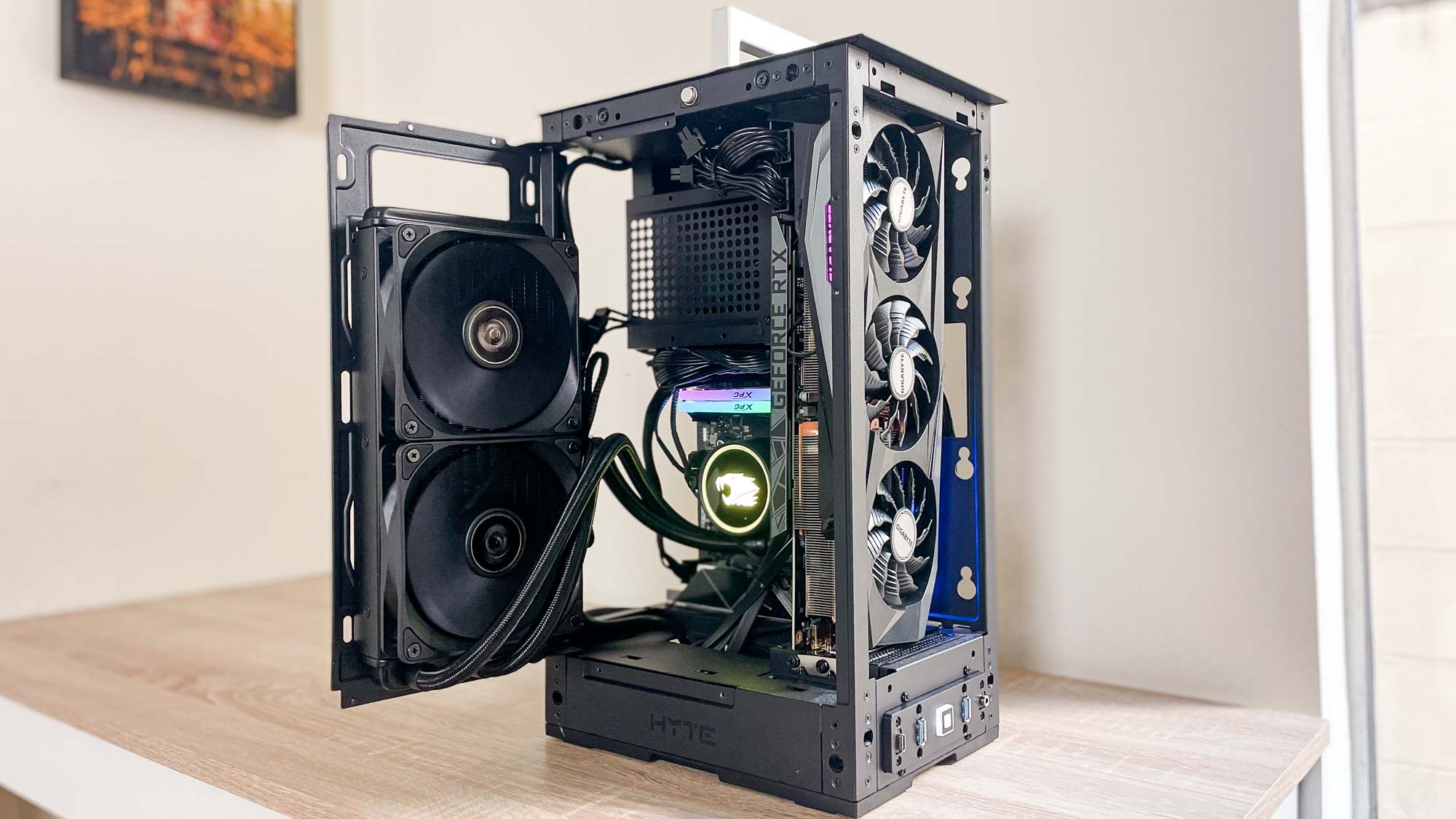
Getting inside the case is a cinch thanks to the easy-open mechanisms which keep each side attached. You can pop off each side individually by pulling gently, which seems easiest when you grab from the bottom and lift the side off with your fingertips. Each side pops off smoothly to reveal your PC's innards, and you can snap it back on by aligning the requisite holes and gently pressing until it clicks in. The whole process is quick and easy once you get the hang of it, and I really like how accessible the Revolt 3 can be — though the tight confines of the tall, compact case make rooting around inside it an exercise in space management.
iBuyPower Revolt 3 review: Gaming performance
- Great performance at 1080p-1440p, and solid performance at 4K
- Competes favorably with far more expensive gaming PCs
I had a great time testing games on our review unit, and its Ryzen 9 CPU and RTX 3080 Ti GPU ensured every game I played out of my Steam library ran well at my monitor's native 1440p. This trashcan-sized gaming rig had no trouble playing games like Apex Legends, Cyberpunk 2077, Dark Souls 3 and Total War: Warhammer 2 at the highest settings, often at 45-60 frames per second.
I was able to play Cyberpunk 2077 for hours with no issues, and with all the settings dialed up and DLSS switched off our review unit consistently kept the game running smoothly at 1440p between 30-40 frames per second. When I played around with DLSS settings I was able to get the game running smoothly at between 40-50 fps, but it couldn't quite reliably deliver 60 frames per second at 1440p.
The noise of the case fans during serious gaming sessions never gets too loud, but it is noticeable. To put it in gaming console terms, I'd say it gets about as loud as an Xbox Series X but not nearly as noisy as a PlayStation 4.

When we put this iBuypower machine through the suite of gaming benchmarks we use, the results were promising, especially if you're interested in 4K gaming. Our review unit managed to deliver 67 frames per second running both Assassin's Creed Valhalla and Grand Theft Auto V at 4K, and 102 fps running Far Cry New Dawn at the same resolution.
| Row 0 - Cell 0 | Acer Predator Orion 3000 | iBuypower Revolt 3 | Maingear Turbo | Origin Chronos |
| Assassin's Creed Valhalla (1080p/4K) | 84/44 | 128/67 | 92/55 | 114/56 |
| Far Cry New Dawn | 94/71 | 124/102 | 121/99 | 106/93 |
| Grand Theft Auto V (1080p/4K) | 129/42 | 176/67 | 173/66 | 145/48 |
| Shadow of the Tomb Raider (1080p/4K) | 111/41 | 168/66 | 168/66 | 128/50 |
| Red Dead Redemption 2 (1080p/4K) | 84/32 | 121/49 | 116/48 | 112/49 |
When we benchmarked Red Dead Redemption 2 at medium settings in 4K this machine still managed to deliver a respectable 49 fps, but when we maxed out RDR2's settings it could only achieve 25 fps at 4K. However, it still managed to hit 59 fps running maxed-out RDR2 in 1080p, which is respectable performance at a still-great resolution.
If you compare that against the performance of the tricked-out Maingear Turbo gaming PC we reviewed recently with similar but beefier components (AMD Ryzen 9 5950X, GeForce RTX 3080 Ti, 64GB RAM, 1TB SSD + 2TB HDD), you'll see how well iBuypower's $3k machine stacks up against a $7k beast of a gaming rig.
As you can see from the chart above, iBuypower's Revolt 3 build reliably delivered equal or better performance as the Maingear Turbo, which achieved 55 fps in Assassin's Creed Valhalla at 4K and 67 fps running GTA 5 at 4K. In fact, the iBuypower PC delivered higher FPS than the Turbo in just about every gaming benchmark we ran it through, an impressive performance for this trim little tower.
iBuyPower Revolt 3 review: Overall performance
- Plenty of power for most tasks, including video editing
- Slow SSD performance in our review unit
Throughout the review process I used our iBuypower review unit as I would my personal PC, and it never once gave me any trouble in that department. I was able to open 30+ tabs in Chrome and keep multiple videos streaming on my desktop while listening to music and working across Chrome and Word with zero difficulties.
Our performance testing backs up my belief that this gaming PC is more than capable of handling whatever tasks you throw at it, including heavy photo/video editing jobs. When we tasked it with transcoding a 4K video down to 1080p in Handbrake it reliably finished the job in 4 minutes 30 seconds, which is faster than the 5 minutes ten seconds the Origin Chronos (AMD Ryzen 7 5800X, GeForce RTX 3070 Ti, 32GB RAM) gaming desktop we recently tested took to complete the same task. However, the $7k Maingear Turbo we tested a few months ago did the same job in 4 minutes and 2 seconds flat, proving there's still room for improvement.
| Row 0 - Cell 0 | Acer Predator Orion 3000 | iBuypower Revolt 3 | Maingear Turbo | Origin Chronos |
| Geekbench 5.4/5.3 (artificial performance benchmark) | 8,048 | 12,366 | 15,764 | 10,707 |
| Copying 25 GB of multimedia files (MBps) | 730 | 513.86 | 2,004 | 1,089 |
| Handbrake video encoding (minutes:seconds) | 7:57 | 4:30 | 4:02 | 5:10 |
The iBuypower's Ryzen 9 CPU performed quite well when we put it through the Geekbench 5.4 multicore CPU benchmark, earning a respectable score of 12,366. That's mid-range performance for a gaming PC that costs this much, but still more than good enough for most people. For comparisons' sake, the cheaper Acer Predator Orion 3000 (Intel Core i7-11700F CPU, GeForce RTX 3070 GPU, 16GB RAM, $1,949 as reviewed) scored a far lower 8,058, while the much more expensive Maingear Turbo blew past both with a score of 15,794.
However, the file transfer speeds of the Western Digital SSD in our iBuypower review unit leave something to be desired. When we tasked it with copying 25GB of multimedia files it did so at a speed of 513.86 MBps, which is acceptable but slower than Acer's more affordable Predator Orion 3000 (730.41 MBps) or the ultra-expensive Maingear Turbo (2,004 MBps).

These figures should give you a better sense of how our iBuypower review unit stacks up against recent competition, but unless you're doing a lot of video production work I don't think there's much here to be concerned about; this PC is more than capable of tackling whatever you need it to do in the course of your day-to-day work.
iBuyPower Revolt 3 review: Software
- No bloatware worth worrying about
The pre-installed software you receive will vary depending on how you configure your iBuypower PC. Our iBuyPower Revolt 3 review unit arrived with a copy of Windows pre-installed, as well as some software for managing component features like the RGB lighting and audio inputs.
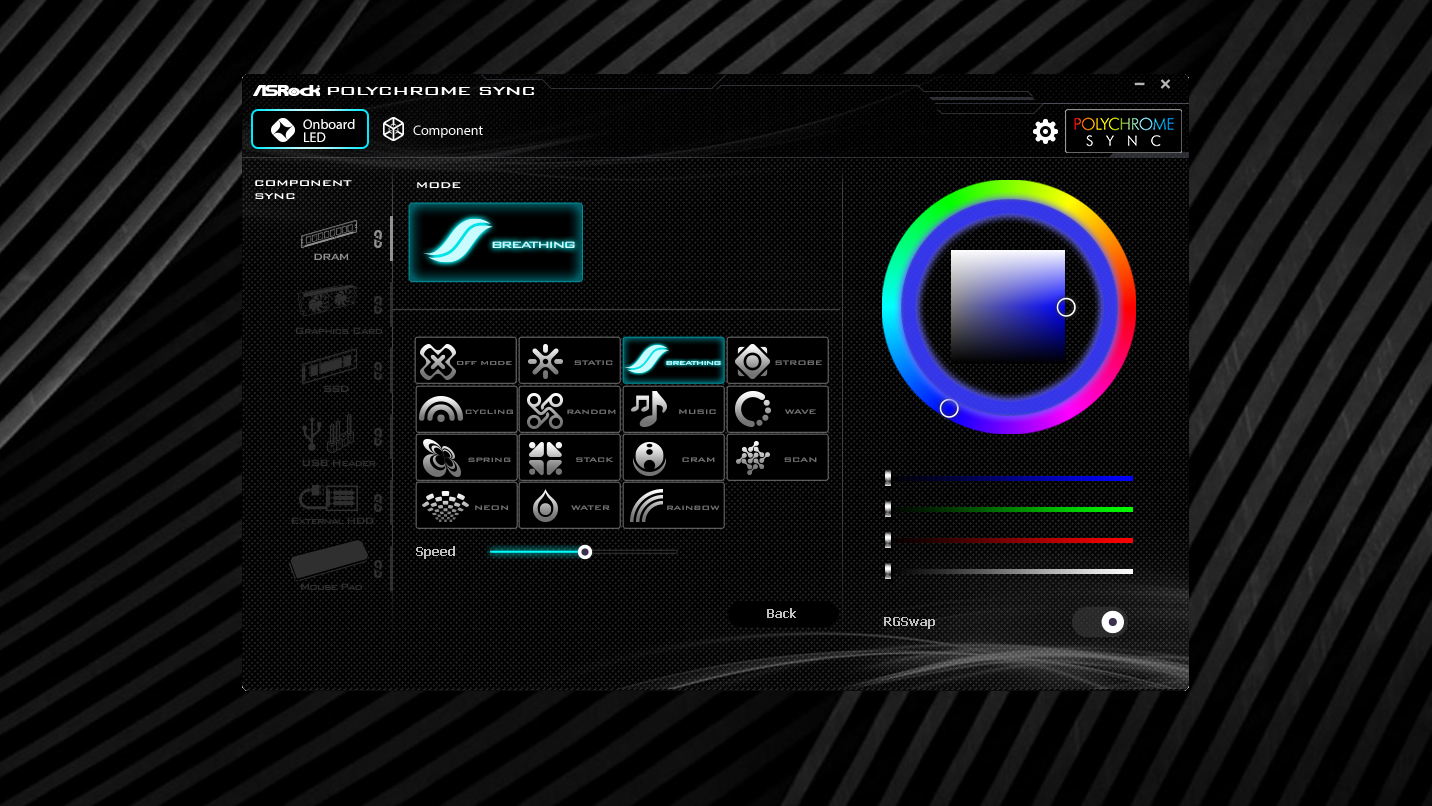
This is exactly what I want to see when I order a new PC: a fresh Windows install with minimal bloatware. Admittedly, the RGB management utility that came pre-installed with the ASRock motherboard in our review unit is pretty spartan in terms of features, but give me a simple software utility over a nagging antivirus suite any day.
iBuyPower Revolt 3 review: Verdict
If you need a powerful, portable gaming PC iBuypower's Revolt 3 does a remarkably good job of delivering on both counts. Portability isn't typically a major selling point for gaming rigs, but the Revolt 3's compact design and built-in handle make it easier to lug around than most. And with options to configure it (as stock permits) with the latest CPUs and GPUs from AMD, Nvidia and Intel, a prebuilt iBuypower rig can be a reliable way to get your hands on highly sought-after gaming PC components.
But whether you opt to configure a prebuilt iBuypower PC or build your own in a Revolt 3 case, be ready to deal with the tower's unique design limitations. Having the ports all located on the bottom or lower front of the case demands you do some careful planning and cable management if you want the PC to fit nicely into your current setup, and the cramped interior demands great care and good cable management when you're working with the components.
Still, I can't help but like the Revolt 3. Our review unit ran every game I could think of playing on it at 1440p with all the settings maxed out without issue, and without ever making more noise than my PlayStation 4. You don't need to spend $3,000 or more to get a great gaming rig, but if you have the option you won't be disappointed by the iBuypower Revolt 3 — especially if you're planning on toting your new PC around on a regular basis.

Alex Wawro is a lifelong tech and games enthusiast with more than a decade of experience covering both for outlets like Game Developer, Black Hat, and PC World magazine. A lifelong PC builder, he currently serves as a senior editor at Tom's Guide covering all things computing, from laptops and desktops to keyboards and mice.
